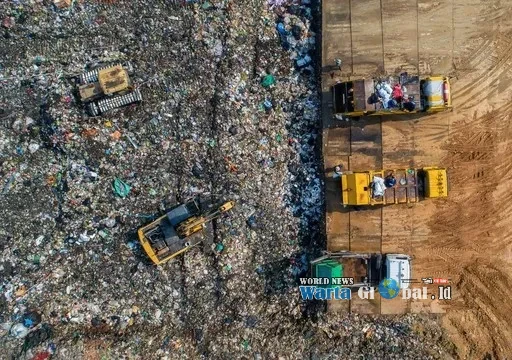
Jakarta, November 14, 2025, WorldWartaGlobal.id
Indonesia is facing a waste crisis. Data from the National Waste Management Information System (SIPSN) in 2024 shows that, out of 328 reporting regencies/cities, national waste generation has reached 34.79 million tons per year. Of this total, 11.55 million tons (33.22%) are properly managed, while 23.23 million tons (66.78%) are inadequately managed. The remainder ends up in landfills (TPA), and is incinerated, primarily through plastic, reaching 6.8 million tons annually.
The Executive Director of the Center for Agrarian and Natural Resources Studies (PPASDA), Muhammad Irvan Mahmud Asia, assessed that population growth and the business sector have led to increased waste production, including from households, restaurants, shopping centers, hotels, and industry. On the other hand, the government and public commitment to this issue is very weak, as evidenced by the waste management system still relying on conventional methods in the form of open dumping and the widespread public habit of disposing of waste in any place.
According to Irvan, the practice of open dumping has treated waste as a burden, not a resource. As a result, landfills (TPA) in many areas are overcapacity, with some even in emergency status. Local governments also lack an integrated waste management strategy, and budget support is very limited.
Regarding this, Irvan stated that waste management in Indonesia is very poor and the impacts have reached a crisis stage. This threatens environmental sustainability, especially soil and clean water, leading to declining residential sanitation quality, and methane emissions, a potent greenhouse gas. Furthermore, the burden on spatial planning is clearly detrimental both economically and socially.
"If serious improvements aren't made, it will become a ticking time bomb because waste accumulation at Final Processing Sites (TPA) has exceeded its capacity (overload); methane gas emissions are increasing, the second-largest contributor to climate change (after carbon dioxide), and even landfill fires (methane gas explosions). This is supported by data from the Indonesian Zero Waste Alliance (AZWI), which shows that as of January 2024, fires had occurred at 38 landfills," he stressed.
Furthermore, Irvan stated that the waste crisis in large cities can cause diseases such as diarrhea, typhus, malaria, and skin diseases.
He also warned that improperly managed waste can lead to flooding. Aesthetically, waste scattered in various corners of the city is very disturbing.
All of these problems will increasingly burden cities in the future, especially with rapid population growth and urbanization, the volume and diversity of waste will undoubtedly increase, while the upstream to downstream system is very fragile. "The root of this fragility lies in our mindset, which doesn't yet see this as a priority. It extends from waste reduction, sorting, collection, and final processing. Essentially, every link in the chain shows structural weaknesses," said Irvan.
If the face of the city is still littered with piles of trash, then it's not just the environment that's dirty, but the mindset and governance that allow it to persist. Until that changes, the face of Indonesian cities will continue to reflect a dismal image.
Views Post


